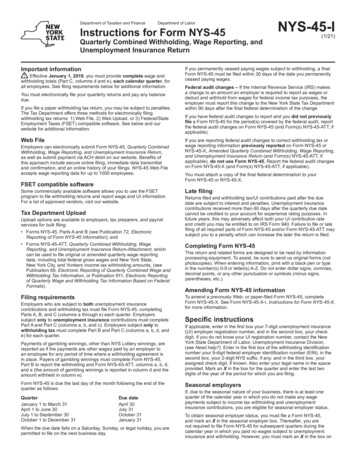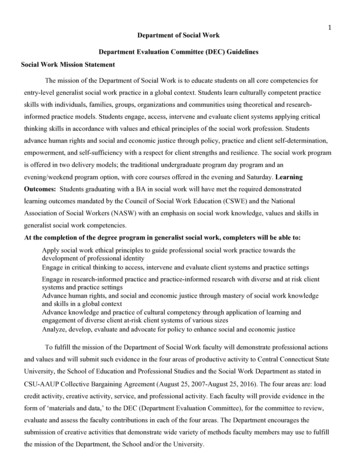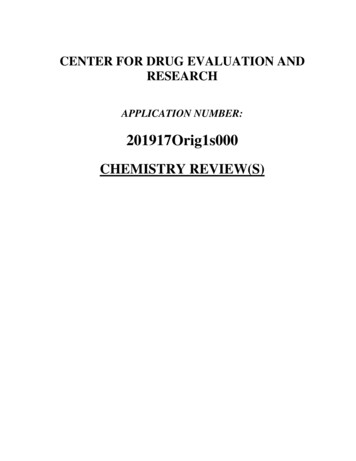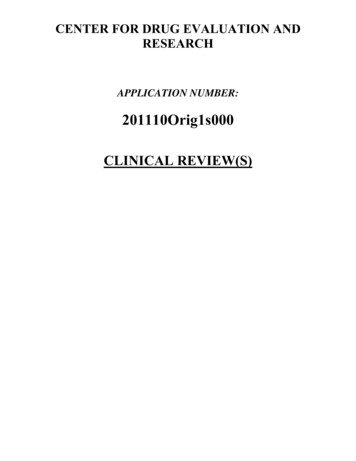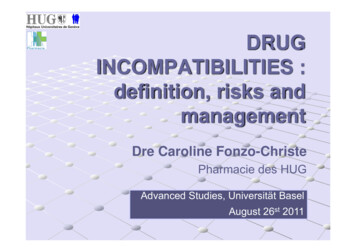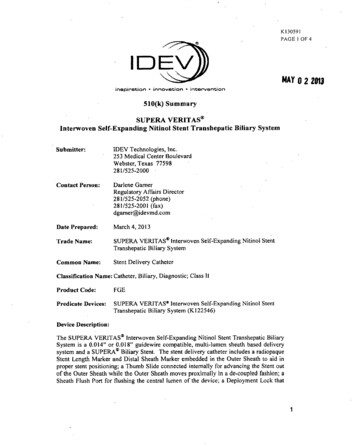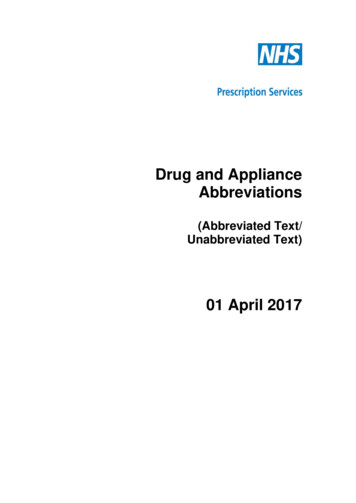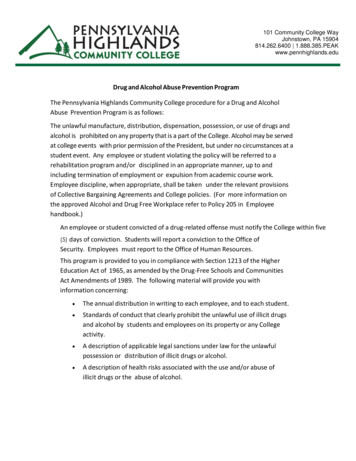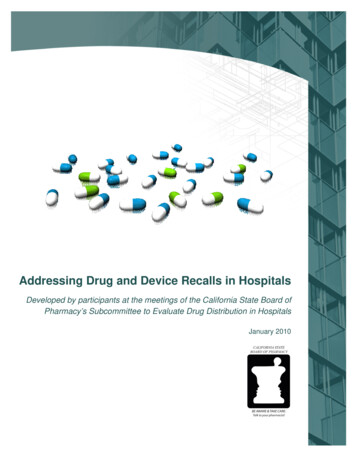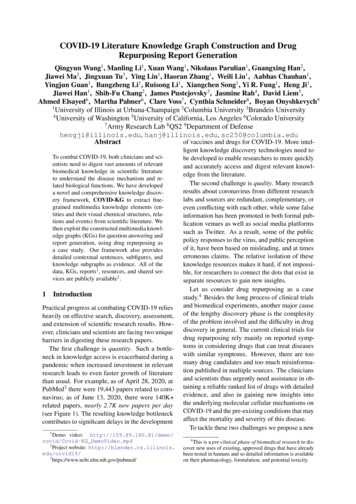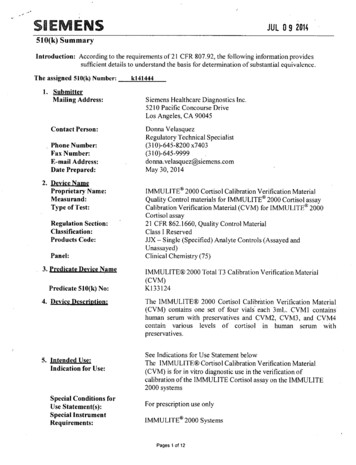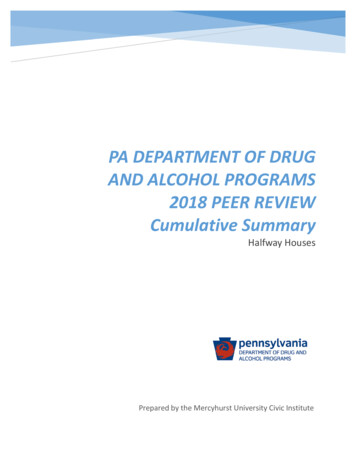
Transcription
PA DEPARTMENT OF DRUGAND ALCOHOL PROGRAMS2018 PEER REVIEWCumulative SummaryHalfway HousesPrepared by the Mercyhurst University Civic Institute
PA DEPARTMENT OF DRUG AND ALCOHOL PROGRAMS 2018 PEER REVIEWCUMULATIVE SUMMARYContentsProject Methodology . 2Pre-Survey Results . 5Cumulative Site Review Summary . 8Prepared by the Mercyhurst University Civic Institute1
PA DEPARTMENT OF DRUG AND ALCOHOL PROGRAMS 2018 PEER REVIEWCUMULATIVE SUMMARYProject MethodologyThe annual Pennsylvania Department of Drug and Alcohol Programs (DDAP) Peer Site Reviewinitiative was conducted during the spring of 2018. This process, which is a requirementmandated by the federal Substance Abuse Prevention and Treatment Block Grant (SAPTBG)funding stream, focuses on a different program type each year. During the process, a minimumof 5% of sites offering the selected programmatic service must be reviewed by peers from likeagencies. Planning for the annual initiative took place in the fall of 2017 through winter of2018, with the actual review process taking place in April and May of 2018.For the 2017-2018 fiscal year, DDAP chose to review Halfway Houses. It has been over adecade since this provision of service was last selected as the program to be reviewed. Withthe adaptation of new treatment modalities and a change in population and drugs of choicesince then, it seemed beneficial to focus the review on this service. A total of five programs hadagreed to participate in this year’s process.Once DDAP representatives secured participating sites, reviewers were recruited to conduct thesite visits. One of the most interesting and unique aspects of this initiative is thatrepresentatives from other agencies visit and conduct interviews with their peers, affordingthem the opportunity to learn best practices in a hands-on discussion-oriented environment.Participants also develop network resources that can be used in their professional careers.Reviewers were matched to sites by geographical proximity, as to keep the reviewers within areasonable drive to the facility that they review. The following table shows the sites reviewedwith the corresponding reviewers and date of visit.SitePA Organization for Women inEarly Recovery (Pittsburgh)The Moffett House (Beaver Falls)New Directions at Cove Forge(Johnstown)Pine Ridge Manor (Tyrone)Retreat at White Birch (Simpson)ReviewersTanaya Curenton and Crystal Kind(The Moffett House)Leslie Slagel and Nishauna Ball(PA Organization of Women in Early Recovery)Leslie Slagel and Nishauna Ball(PA Organization of Women in Early Recovery)Marsha Zablotney and Krystal Webb(New Directions at Cove Forge)Melanie Dotts(Pine Ridge Manor)Date of ReviewMay 23May 31May 24May 11May 16The Mercyhurst University Civic Institute (MCI) has been assisting DDAP with the coordinationand analysis of the peer review process since the 2006-2007 fiscal year. The MCI, based in Erie,PA, has a history of conducting program evaluations for state and local juvenile, family, criminalPrepared by the Mercyhurst University Civic Institute2
PA DEPARTMENT OF DRUG AND ALCOHOL PROGRAMS 2018 PEER REVIEWCUMULATIVE SUMMARYjustice, and drug and alcohol programs. DDAP representatives and MCI staff structured thereview process in a manner that focused on qualitative information such as strengths,weaknesses, work processes, and organizational behavior, while placing less emphasis onstatistics and demographic data.The peer review process consisted of three data collection tools. The first two were distributedpre-site visit and centered on gathering preliminary information. The first piece was a presurvey that was designed to gather input from all staff at each program, not just those whowould be interviewed during the site visit. The survey consisted of 30 statements about variousprogram traits on which respondents were asked to note their level of agreement using a LikertScale. In addition, the survey consisted of 16 topics on which the respondents were asked touse a Likert Scale to rate their agency’s performance. To maintain anonymity (partiallystemming from small staff sizes at some participating sites), the surveys would be analyzedacross all site reviews, as opposed to being site-specific. Coinciding with the pre-survey was adirector’s survey. The purpose of this tool was to gather statistical information on the programand its performance that would not be relevant to those being interviewed. Copies of thesetools can be found in the Appendix.The third tool was used for gathering information during the site visits for the Peer Site Reviewprocess. MCI staff designed a tool that would guide the reviewers in their interviews withagency staff. The survey was broken down into five sections and 27 total questions based on:Intake, Client Interaction, Treatment and Services, Staffing and Administration, and othermiscellaneous topics. The complete site visit survey tool can be found in the Reviewer Guidelocated in the Appendix of the Cumulative Site Report accompanying this document.Interviewee responses can be found in each site’s individual report.In order to prepare the reviewers for the site visits, an in-depth reviewer’s guide was developedand sent to participating reviewers. This guide included all materials needed to conduct thereview, pertinent contact information, reimbursement forms, interviewing tips, and a copy ofthe site visit survey tool. Reviewers were asked to participate in one of two conference calls(April 16th or April 19th) led by MCI staff. The conference calls were set up to review thetraining manual, questions on the site visit survey tool, and responsibilities of the sitereviewers.Immediately after the conference calls took place, site contacts were informed that a reviewerwould be in touch within the next two weeks to set up a date for the visit. In addition, it wasrequested that each site have six staff available for interviews on the day of the site review, ifpossible. Once the reviews were completed, reviewers were asked to report back to MCI withPrepared by the Mercyhurst University Civic Institute3
PA DEPARTMENT OF DRUG AND ALCOHOL PROGRAMS 2018 PEER REVIEWCUMULATIVE SUMMARYreview findings by May 31st. MCI staff then compiled final results for each individual site aswell as an overall analysis. A final report was compiled and delivered to DDAP officials in June2018.Prepared by the Mercyhurst University Civic Institute4
PA DEPARTMENT OF DRUG AND ALCOHOL PROGRAMS 2018 PEER REVIEWCUMULATIVE SUMMARYPre-Survey ResultsThe first portion of the site review process was the administration of a pre-survey. All staffmembers associated with the Halfway House programs reviewed were asked to participate.The pre-survey focused on organizational and operational behaviors within each facility. Inaddition, the survey asked respondents to rate areas of operations that are pertinent toorganizational functions. The survey allowed a greater number of staff members to have inputin the review process and supplemented the data collected from the interviews conductedduring the site review. The results that follow are cumulative for all participating sites, due tothe small number of returns from some of the programs. Analyzing individual site returnswould not be feasible and may, in fact, allow for breach of anonymity with responses.Part OnePart one of the pre-survey consisted of a list of 30 statements to which survey participants wereasked to rate their level of agreement using a 5-point Likert scale (1 Strongly Disagree, 5 Strongly Agree) for each item. In addition, a column of Not Sure/Not Applicable was provided.Analysis of results consisted of ranking each statement by highest level of agreement to lowestlevel of agreement. High agreement statements (more than 75% of respondents either stronglyagreed or agreed) are those that were generally supported by the respondents and areidentified in blue text. Low agreement statements (less than 25% of respondents eitherstrongly agreed or agreed) and high disagreement statements (more than 50% of respondentseither disagreed or strongly disagreed) are identified with red text. These percentages werechosen only for sampling purposes. The complete table of statements has been re-ranked inorder of highest agreement to lowest agreement for this report.N 38SA&AN&NAD&SDStaff members are able to build rapport with clients in a reasonableamount of time.89%5%5%Clients are made well aware of the program expectations when theyare admitted.87%13%0%Our program provides clients appropriate access to medicalconsultations and tests if needed.87%11%3%Our staff members do a thorough job of assessing clients’ problems andneeds.87%13%0%Clients’ treatment is adjusted based on their changing needs.87%8%5%The interventions utilized are useful in meeting clients’ needs.84%13%3%Clients are connected with aftercare services.84%14%3%Clients are encouraged to participate in positive social activities.84%11%5%Our program staff are dedicated to maintaining client confidentiality.82%13%5%Staff begin coordinating aftercare services for clients prior to discharge.76%22%3%Prepared by the Mercyhurst University Civic Institute5
PA DEPARTMENT OF DRUG AND ALCOHOL PROGRAMS 2018 PEER REVIEWN 38Staff members have knowledge of the challenges faced by our clients.My personal workspace is conducive to completing my jobresponsibilities.Our program staff collaborate well with key agencies in our community.Staff members are willing to try new things to improve treatment.Our program staff have access to technology as needed.Clients have access to occupational and vocational counseling.Clients view this program as beneficial to their treatment.I trust the professional judgment of my coworkers.Staff members maintain appropriate professional boundaries withclients.Our program has a clear definition of client success.Staff members cooperate with one another in a way that supports theprogram.I am satisfied with the training available to staff.Our physical building is conducive to meeting our clients’ needs.Our agency creates an environment in which professional growth isencouraged.Staff members communicate well with one another.The community has a favorable view of our program.Staff members feel they are supported by management.Staff members report a sense of high morale.We have adequate staff in place to meet our clients’ needs.Employee wages and benefits are appropriate and comparable withthose at similar agencies.CUMULATIVE ryOverall, 10 of the 30 statements were met with high levels of agreement. The statement withthe highest level of agreement was “Staff members are able to build rapport with clients in areasonable amount of time”, with 89% or respondents either Strongly Agreed or Agreed. Fourstatements were met with 87% high level of agreement: “Clients are made well aware of theprogram expectations when they are admitted”; “Our program provides clients appropriateaccess to medical consolations and tests if needed”; “Our staff members do a thorough job ofassessing clients’ problems and needs”; “Clients’ treatment is adjusted based on their changingneeds.” One of the statements was identified as being high disagreement or low agreement (inthis case both, with 21% level of agreement and 53% level of disagreement): “Employee wagesand benefits are appropriate and comparable with those at similar agencies.”Prepared by the Mercyhurst University Civic Institute6
PA DEPARTMENT OF DRUG AND ALCOHOL PROGRAMS 2018 PEER REVIEWCUMULATIVE SUMMARYPart TwoPart two of the pre-survey consisted of a list of 16 general themes related to organizationalactivities and traits. Survey participants were asked to rate their view of their program’s overallperformance on a 5-point Likert scale varying from 5 Very Strong to 1 Weak. Though therewere not any of the following identified, High strength statements (more than 75% ofrespondents answered Very Strong or Strong) are those that were generally supported by therespondents and are identified in blue text, and low strength statements (less than 25% ofrespondents responded very strong or strong) and high weakness statements (more than 50%of respondents either somewhat weak or weak) are identified with red text. Thesepercentages were chosen only for sampling purposes. The analysis below consists of rankingeach statement from greatest identified strength to lowest identified strength.N 38Staff-Client RelationshipsTreatment Components/ ProgrammingIntake processTreatment PlanningPerception within Treatment CommunityWorking ConditionsProfessional DevelopmentStaff- Management RelationshipsRelationships with Outside AgenciesManagement PerformanceCo-worker RelationshipsStaff ProfessionalismCommunicationAftercare PlanningTechnology AccessStaff MoraleVS & S73%65%65%63%62%59%59%59%59%57%57%57%56%55%43%38%N & SW & None of the topic areas were met with either high levels of agreement or levels ofdisagreement. The highest rated area (73%) was Staff-Client Relationships, while the area withthe lowest level of performance was Staff Morale (38%).NOTE: The reader should understand that the data from the pre-surveys may or may notreflect the overall feeling of all staff working within the programs or agencies. The readershould recognize that other issues may weigh in on the performance of the organizationsbeyond those noted in the summarized findings of the pre-survey.Prepared by the Mercyhurst University Civic Institute7
PA DEPARTMENT OF DRUG AND ALCOHOL PROGRAMS 2018 PEER REVIEWCUMULATIVE SUMMARYCumulative Site Review SummaryThe peer site reviews of Halfway Houses were completed during May of 2018, as theculmination of the entire process which took place from December 2017 through June 2018.Specifics regarding dates of reviews and reviewer-site pairings can be found in the projectmethodology section of this report. This report is a generalized summary of system-widefindings from the reviews. Individual site-specific reports were created for each program thatparticipated in the process.Topic 1: IntakeAcross sites, interviewees were asked to identify what works well with their intake processes.Respondents typically felt that their processes work well and are effective. In most cases theclients are made to feel welcome immediately. Some programs noted that the intake processitself does not take a long time; however, the assessment process is often added on and candraw the process out.There are a few roadblocks that cause difficulty in the process at times. The most notableissues that cause difficulty are the redundancy and significant amount of paperwork that isrequired for intake. Often times, proper paperwork is not completed or submitted by theprogram that the client is arriving from. Clients are often dishonest with their answers duringthe process; respondents suspected that this is for fear of being denied services.The interviewees were asked what they could recommend to make the intake process better.The most frequent suggestion was reducing the amount of paperwork required. Anothercomment given multiple times was dealing with dishonesty in clients; however, no one hadideas on how to circumvent that issue.Topic 2: Client InteractionThe second section of questions pertained to client needs and behaviors. Respondents notedthat other than treatment, housing tends to be one of the most pressing needs of their clients.In many cases, clients enter the program homeless; others have difficulty finding affordable,stable, and safe housing. Respondents also cited the need for mental health services as criticalto their client’s well-being. Other top needs are employment and vocational services, life skills,and transportation, among others.Prepared by the Mercyhurst University Civic Institute8
PA DEPARTMENT OF DRUG AND ALCOHOL PROGRAMS 2018 PEER REVIEWCUMULATIVE SUMMARYUpon entering the program, clients seek to achieve more than sobriety. Educationalachievement and gaining meaningful employment are important. Many clients have burnedbridges with their families so they wish to reconnect and rebuild relationships. Rebuildingthese relationships appears to be important to anyone who is engaged in services.Interviewees were asked to discuss client behaviors, attitudes and attributes. Successful clientstypically are open, honest and gracious. They are willing to work hard at their recovery efforts,follow rules, and do what is asked of them. Those that are unsuccessful typically have a senseof entitlement, possess a poor attitude, and do not respect authority. More often than not,unsuccessful clients are in their program because of external motivators, such as courtsentencing.Topic 3: Treatment and ServicesInterviewees were asked if they find that clients benefit from completing and updatingtreatment plans, as well as what evidence-based practices are offered. Clients are able to gainownership of their treatment and address varying needs throughout the processes. The plansalso help to keep clients on track for completing what is required of them. Overwhelmingly,this is a helpful process; however, it was said that administrative plan requirements can weighdown needed treatment. The programs engage clients in many traditional evidence-basedpractices including Motivational Interviewing, Reality Therapy, Cognitive Behavioral Therapy,and the 12-step program.Successful discharges are most commonly defined by clients meeting most or all of theirtreatment goals and having a safe and sober place to return upon release. Other aspectsdefining success include reconnecting with family, gaining and maintaining employment, andgaining financial stability.All of the programs assist clients with their aftercare; some do more than others. At minimum,the programs assist in lining up services for a client upon discharge. Many are more engaged inthe process and conduct follow-ups to assure the client is doing well. Programs often set upmental health services and other appointments when a client is released. In order to improvethe discharge processes, respondents suggested that sites could benefit from a designateddischarge planner or case manager to handle such duties. Others suggested more rapid accessto mental health services and starting the process earlier while at the halfway house.Prepared by the Mercyhurst University Civic Institute9
PA DEPARTMENT OF DRUG AND ALCOHOL PROGRAMS 2018 PEER REVIEWCUMULATIVE SUMMARYWhile in treatment, clients also may be in need of other skill development or assistance to helpthem in their recovery. Respondents were asked how the following may be included in theirprogramming. These are summaries of the results given during the visits: Vocational Assessments: programs do assess for these needs, but will make referrals toOVR for better servicesJob Readiness/Placement: life skills coordinators are often used, but outside providersare most frequently used for the actual servicesGED Prep/Testing: common sources utilized are county-based programs, OVR, and localschoolsLiteracy and Basic Education Tutoring: common sources utilized are the local libraries,community colleges, and adult literacy programsMedical Care: a couple of the sites have medical staff that come in regularly to examineclients, another benefits from a doctor’s office across the street; all refer out for servicesin the communityDental Care: most programs have relationships with dentist offi
Early Recovery (Pittsburgh) Tanaya Curenton and Crystal Kind (The Moffett House) May 23 The Moffett House (Beaver Falls) Leslie Slagel and Nishauna Ball (PA Organization of Women in Early Recovery) May 31 New Directions at Cove F
